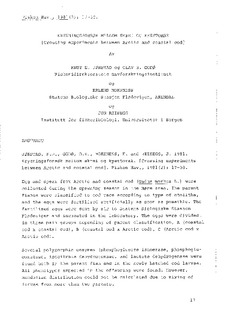Krysningsforsøk mellom skrei og kysttorsk
Research report
Permanent lenke
http://hdl.handle.net/11250/112717Utgivelsesdato
1981Metadata
Vis full innførselSamlinger
- Fisken og havet (1958- ) [700]
Sammendrag
Egg and sperm from Arctic and coastal cod (Gadus morhua L.) were
collected during the spawning season in the Møre area. The parent
fishes were classified to cod race according to type of otoliths,
and the eggs were fertilized artificially as soon as possible. The
fertilized eggs were sent by air to Statens Biologiske Stasjon
Flødevigen and incubated in the laboratory. The eggs were divided.
in three main groups depending of parent classification, A (coastal
cod x coastal cod), B (coastal cod x Arctic cod), C (Arctic cod x
Arctic cod) .
Several polymorphic enzymes (phosphoglucose isomerase, phosphoglucomutase,
isocitrate dehydrogenase, and lactate dehydrogenase were
found both in the parent fish and in the newly hatched cod larvae.
All phenotypes expected in the offspring were found. However,
mendelian distribution could not be calculated due to mixing of
larvae from more than two parents.
During the first 30 days after hatching, offspring from the crossing
between Arctic and coastal cod seemed to have a reduced growth
rate compared to the other groups. Due to low enzyme activity in
these larvae, the phenotypic classification in this group was
difficult.
A detailed genetic analysis of group B and C, before and after
first feeding, show a significant change in the distribution of
phenotypes and allel frequencies. The observed changes could be due
to selection on phenotypes or may reflect different egg qualities
for some of the parents used. The genetic analysis demonstrated,
however, that changes occur during the first feeding stage, indicating
that genetic selection can take place in this period of
larval development.
Utgiver
HavforskningsinstituttetSerie
Fisken og havet1981-02
